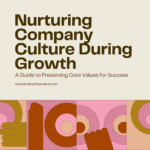As companies grow beyond the startup phase, it is quite common for them to undergo mergers or acquisitions. These processes often lead to a consolidation of talent, resulting in teams comprising engineers who specialise in different technologies. While this diversity in programming languages can present certain challenges, it is not a critical factor that hinders team success. What truly matters is establishing a clear shared goal, fostering understanding of the goal and strategy among team members, and creating an environment where everyone feels responsible for the team’s overall success. We’ve covered the biggest challenge beyond the startup in chapter 3. In this blog post, we will focus on strategies to help you build and manage teams with mixed tech stacks effectively.
1. Define a Clear Shared Goal
The foundation of any successful team, regardless of their tech stack diversity, is a clear shared goal. The team should have a common understanding of what they are striving to achieve and how their work aligns with broader organisational objectives. OKRs could be a great framework to consider, if you are struggling with building the alignment between your technical strategy and goals and company objectives. When team members are united by a common purpose, it fosters collaboration and minimises potential conflicts arising from differences in tech stacks.
2. Encourage Open Communication and Knowledge Sharing
Mixed tech stacks can create knowledge silos, where team members become isolated in their respective areas of expertise. To overcome this, establish a culture of open communication and knowledge sharing within the team. Encourage team members to share their expertise, ask questions, and seek clarification when needed. This approach promotes cross-pollination of ideas and allows individuals to learn from each other, leading to a more well-rounded and versatile team.
3. Foster a Learning Culture
In a team with mixed tech stacks, individuals may encounter technologies or programming languages they are less familiar with. To mitigate potential knowledge gaps and ensure continuous growth, foster a learning culture within the team. Encourage team members to expand their skill sets by providing resources, organizing internal training sessions, or even allowing time for experimentation and exploration. By investing in the professional development of your team, you enable them to adapt and overcome any challenges posed by the diversity of tech stacks.
4. Establish Collaborative Practices and Tools
Collaboration is the key to success in teams with mixed tech stacks. To facilitate effective collaboration, establish practices and tools that encourage teamwork and information sharing. Implement version control systems, project management tools, and documentation platforms that enable seamless collaboration and ensure that everyone is on the same page. Additionally, consider implementing regular code reviews and pair programming sessions to foster knowledge transfer and maintain code quality.
5. Emphasise Outcome and Impact
While different tech stacks may require different approaches and tools, it is crucial to shift the team’s focus towards the outcome and impact of their work. Instead of getting caught up in debates over which programming language or technology is cooler, emphasise the importance of delivering high-quality results that align with the shared goal. When team members understand the value they contribute and see the impact of their work, they are more likely to collaborate effectively and overcome any challenges that arise due to tech stack diversity.
6. Cultivate a Sense of Ownership and Accountability
To ensure the success of teams with mixed tech stacks, it is essential to cultivate a sense of ownership and accountability among team members. Encourage individuals to take ownership of their tasks, regardless of the technology they are working with. By establishing an environment where everyone feels responsible for the team’s overall success, you foster a culture of collaboration, proactiveness, and continuous improvement.
Conclusion
Building effective teams with mixed tech stacks is not about eliminating the challenges that come with diversity; it is about leveraging that diversity to drive success. By establishing a clear shared goal, promoting open communication and knowledge sharing, fostering a learning culture, and emphasising outcome and impact, you can create an environment where teams thrive despite their differences in programming languages. Ultimately, when team members understand the goal, strategy, and their individual contributions, they can collaborate effectively and achieve outstanding results, regardless of their tech stack diversity. There is a great book I would definitely recommend on reading, by Esther Derby and Diana Larsen, Agile Retrospectives: Making Good Teams Great, that could be a great resource with many great ideas.
And if you have some success stories to share about building teams with mixed tech stacks, or have a question or need some help, please feel free to leave a comment below or get in touch with me. I’m always happy to help.



